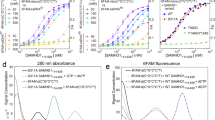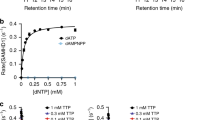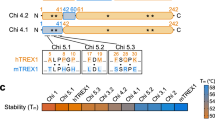Abstract
SAMHD1, a dNTP triphosphohydrolase (dNTPase), has a key role in human innate immunity. It inhibits infection of blood cells by retroviruses, including HIV, and prevents the development of the autoinflammatory Aicardi–Goutières syndrome (AGS). The inactive apo-SAMHD1 interconverts between monomers and dimers, and in the presence of dGTP the protein assembles into catalytically active tetramers. Here, we present the crystal structure of the human tetrameric SAMHD1–dGTP complex. The structure reveals an elegant allosteric mechanism of activation through dGTP-induced tetramerization of two inactive dimers. Binding of dGTP to four allosteric sites promotes tetramerization and induces a conformational change in the substrate-binding pocket to yield the catalytically active enzyme. Structure-based biochemical and cell-based biological assays confirmed the proposed mechanism. The SAMHD1 tetramer structure provides the basis for a mechanistic understanding of its function in HIV restriction and the pathogenesis of AGS.
This is a preview of subscription content, access via your institution
Access options
Subscribe to this journal
Receive 12 print issues and online access
$189.00 per year
only $15.75 per issue
Buy this article
- Purchase on Springer Link
- Instant access to full article PDF
Prices may be subject to local taxes which are calculated during checkout





Similar content being viewed by others
References
Descours, B. et al. SAMHD1 restricts HIV-1 reverse transcription in quiescent CD4+ T-cells. Retrovirology 9, 87 (2012).
Baldauf, H.M. et al. SAMHD1 restricts HIV-1 infection in resting CD4+ T cells. Nat. Med. 18, 1682–1687 (2012).
Laguette, N. et al. SAMHD1 is the dendritic- and myeloid-cell-specific HIV-1 restriction factor counteracted by Vpx. Nature 474, 654–657 (2011).
Hrecka, K. et al. Vpx relieves inhibition of HIV-1 infection of macrophages mediated by the SAMHD1 protein. Nature 474, 658–661 (2011).
Berger, A. et al. SAMHD1-deficient CD14+ cells from individuals with Aicardi-Goutieres syndrome are highly susceptible to HIV-1 infection. PLoS Pathog. 7, e1002425 (2011).
St Gelais, C. et al. SAMHD1 restricts HIV-1 infection in dendritic cells (DCs) by dNTP depletion, but its expression in DCs and primary CD4+ T-lymphocytes cannot be upregulated by interferons. Retrovirology 9, 105 (2012).
Lahouassa, H. et al. SAMHD1 restricts the replication of human immunodeficiency virus type 1 by depleting the intracellular pool of deoxynucleoside triphosphates. Nat. Immunol. 13, 223–228 (2012).
Kim, B., Nguyen, L.A., Daddacha, W. & Hollenbaugh, J.A. Tight interplay among SAMHD1 protein level, cellular dNTP levels, and HIV-1 proviral DNA synthesis kinetics in human primary monocyte-derived macrophages. J. Biol. Chem. 287, 21570–21574 (2012).
Xin, B. et al. Homozygous mutation in SAMHD1 gene causes cerebral vasculopathy and early onset stroke. Proc. Natl. Acad. Sci. USA 108, 5372–5377 (2011).
Rice, G.I. et al. Mutations involved in Aicardi–Goutieres syndrome implicate SAMHD1 as regulator of the innate immune response. Nat. Genet. 41, 829–832 (2009).
Crow, Y.J. & Rehwinkel, J. Aicardi-Goutieres syndrome and related phenotypes: linking nucleic acid metabolism with autoimmunity. Hum. Mol. Genet. 18, R130–R136 (2009).
Jepps, H., Seal, S., Hattingh, L. & Crow, Y.J. The neonatal form of Aicardi-Goutières syndrome masquerading as congenital infection. Early Hum. Dev. 84, 783–785 (2008).
Powell, R.D., Holland, P.J., Hollis, T. & Perrino, F.W. Aicardi-Goutieres syndrome gene and HIV-1 restriction factor SAMHD1 is a dGTP-regulated deoxynucleotide triphosphohydrolase. J. Biol. Chem. 286, 43596–43600 (2011).
Goldstone, D.C. et al. HIV-1 restriction factor SAMHD1 is a deoxynucleoside triphosphate triphosphohydrolase. Nature 480, 379–382 (2011).
Yan, J. et al. Tetramerization of SAMHD1 is required for biological activity and inhibition of HIV infection. J. Biol. Chem. 288, 10406–10417 (2013).
White, T.E. et al. Contribution of SAM and HD domains to retroviral restriction mediated by human SAMHD1. Virology 436, 81–90 (2013).
Brandariz-Nuñez, A. et al. Role of SAMHD1 nuclear localization in restriction of HIV-1 and SIVmac. Retrovirology 9, 49 (2012).
DeLucia, M., Mehrens, J., Wu, Y. & Ahn, J. HIV-2 and SIVmac accessory virulence factor Vpx down-regulates SAMHD1 catalysis prior to proteasome-dependent degradation. J. Biol. Chem. 288, 19116–19126 (2013).
Vorontsov, I.I. et al. Characterization of the deoxynucleotide triphosphate triphosphohydrolase (dNTPase) activity of the EF1143 protein from Enterococcus faecalis and crystal structure of the activator-substrate complex. J. Biol. Chem. 286, 33158–33166 (2011).
Oganesyan, V., Adams, P.D., Jancarik, J., Kim, R. & Kim, S.H. Structure of O67745_AQUAE, a hypothetical protein from Aquifex aeolicus. Acta Crystallogr. Sect. F Struct. Biol. Cryst. Commun. 63, 369–374 (2007).
Aravind, L. & Koonin, E.V. The HD domain defines a new superfamily of metal-dependent phosphohydrolases. Trends Biochem. Sci. 23, 469–472 (1998).
White, T.E. et al. The retroviral restriction ability of SAMHD1, but not its deoxynucleotide triphosphohydrolase activity, is regulated by phosphorylation. Cell Host Microbe 13, 441–451 (2013).
Cribier, A., Descours, B., Valadão, A. L., Laguette, N. & Benkirane, M. Phosphorylation of SAMHD1 by Cyclin A2/CDK1 regulates its restriction activity toward HIV-1. Cell Rep. 3, 1036–1043 (2013).
Errico, A., Deshmukh, K., Tanaka, Y., Pozniakovsky, A. & Hunt, T. Identification of substrates for cyclin dependent kinases. Adv. Enzyme Regul. 50, 375–399 (2010).
Beloglazova, N. et al. Nuclease activity of the human SAMHD1 protein implicated in the Aicardi-Goutieres Syndrome and HIV-1 restriction. J. Biol. Chem. 288, 8101–8110 (2013).
Goncalves, A. et al. SAMHD1 is a nucleic-acid binding protein that is mislocalized due to Aicardi-Goutieres syndrome-associated mutations. Hum. Mutat. 33, 1116–1122 (2012).
Zimmerman, M.D., Proudfoot, M., Yakunin, A. & Minor, W. Structural insight into the mechanism of substrate specificity and catalytic activity of an HD-domain phosphohydrolase: the 5′-deoxyribonucleotidase YfbR from Escherichia coli. J. Mol. Biol. 378, 215–226 (2008).
Kondo, N. et al. Structure of dNTP-inducible dNTP triphosphohydrolase: insight into broad specificity for dNTPs and triphosphohydrolase-type hydrolysis. Acta Crystallogr. D Biol. Crystallogr. 63, 230–239 (2007).
Kondo, N., Kuramitsu, S. & Masui, R. Biochemical characterization of TT1383 from Thermus thermophilus identifies a novel dNTP triphosphohydrolase activity stimulated by dATP and dTTP. J. Biochem. 136, 221–231 (2004).
Stuart, D.I., Levine, M., Muirhead, H. & Stammers, D.K. Crystal structure of cat muscle pyruvate kinase at a resolution of 2.6 A. J. Mol. Biol. 134, 109–142 (1979).
Diamond, T.L. et al. Macrophage tropism of HIV-1 depends on efficient cellular dNTP utilization by reverse transcriptase. J. Biol. Chem. 279, 51545–51553 (2004).
Chayen, N.E., Shaw Stewart, P.D., Maeder, D.L. & Blow, D.M. An automated system for micro-batch protein crystallization and screening. J. Appl. Crystallogr. 23, 297–302 (1990).
McCoy, A.J. et al. Phaser crystallographic software. J. Appl. Crystallogr. 40, 658–674 (2007).
Cowtan, K. The Buccaneer software for automated model building. 1. Tracing protein chains. Acta Crystallogr. D Biol. Crystallogr. 62, 1002–1011 (2006).
Vagin, A.A. et al. REFMAC5 dictionary: organization of prior chemical knowledge and guidelines for its use. Acta Crystallogr. D Biol. Crystallogr. 60, 2184–2195 (2004).
Emsley, P. & Cowtan, K. Coot: model-building tools for molecular graphics. Acta Crystallogr. D Biol. Crystallogr. 60, 2126–2132 (2004).
Davis, I.W. et al. MolProbity: all-atom contacts and structure validation for proteins and nucleic acids. Nucleic Acids Res. 35, W375–83 (2007).
Connor, R.I., Chen, B.K., Choe, S. & Landau, N.R. Vpr Is required for efficient replication of human immunodeficiency virus type-1 in mononuclear phagocytes. Virology 206, 935–944 (1995).
Acknowledgements
We thank X. Jia, E. Weber, J. Fribourgh, H. Nguyen and B. Summers for assistance and discussion and Y. Zuo, Y. Li and C. Wang for technical assistance. We also thank the staff at the Advanced Photon Source beamline 24-ID and the National Synchrotron Light Source beamline X25. We thank N. Landau (New York University School of Medicine), T. Hope (Northwestern University) and D. McDonald (Case Western Reserve University) for supplying reagents. This work was supported in part by funds from the University of Pittsburgh School of Medicine (J.A.) and by US National Institutes of Health grants AI097064 (Y.X.), AI100673 (J.S.) and P50GM82251 (A.M.G. and J.A.).
Author information
Authors and Affiliations
Contributions
X.J. performed protein crystallization, structure determination and structure analysis; X.J. and H.Y. collected the diffraction data; Y.W., J.M., M.D. and J.A. performed the biochemical mutation experiments and data analysis in vitro; J.Y. and C.H. performed the cell-based experiments; J.A. provided experimental materials; X.J., Y.W., J.Y., H.Y., A.M.G., J.S., J.A. and Y.X. analyzed the data; X.J., Y.W., J.S., J.Y., J.A. and Y.X. designed the experiments; and X.J., H.Y., A.M.G., J.S., J.A. and Y.X. wrote the manuscript.
Corresponding authors
Ethics declarations
Competing interests
The authors declare no competing financial interests.
Integrated supplementary information
Supplementary Figure 1 Structure comparison of SAMHD1c2 and SAMHD1c1.
(a) Structure superposition of SAMHD1c1 and SAMHD1c2. The structure of SAMHD1c2 has been aligned to SAMHD1c1 using SHP1. The SAMHD1c1 missing region is highlighted in red in the SAMHD1c2 structure. (b) Putty representation of the dimer-1 interface with little altered conformation. The color spectrum and the coil thickness represent the deviation of the aligned Cα atoms in the two structures, which varies from rmsd 1 Å (blue) to rmsd 7.4 Å (orange). The disordered regions in SAMHD1c1 are colored red and displayed with large thickness. Residues 113–119 which are not included in SAMHD1c1 are marked in black.
Supplementary Figure 2 2D representation of dGTP–Mg2+–dGTP interactions at the allosteric site.
dGTPs and SAMHD1 interaction residues are shown as lines and hydrogen bonds are shown as black dashed lines with distances marked. Residues were colored according to subunit: A – light blue, C – light red, D – wheat. The magnesium ion and a water molecule are shown as spheres. The interactions were analyzed and plotted by using Ligplot2.
Supplementary Figure 3 dGTPs at the allosteric site.
(a) Modeling of GTPs at the allosteric site. The dGTP-binding pocket at the allosteric site is shown in surface representation and the SAMHD1 subunits are colored the same as in Figure 1. GTPs are placed at the positions of dGTP-1 and dGTP-2 sites as black sticks. Residues V117 and F157 were drawn as sticks to show the steric hindrance to the 2'-hydroxyl group of the ribose. Binding of GTPs at the allosteric site would require a conformational change involving these residues. (b) The geometry of dGTP–Mg2+–dGTP at the allosteric site. The magnesium ion binds to five oxygen atoms of the β or γ phosphate groups from both of the two dGTP molecules and one ordered water in an octahedral geometry. dGTPs are shown as sticks. The Mg2+ ion (yellow) and water (red) are shown as spheres. The 2Fo–Fc electron density maps (σ=1.5) are shown as meshes. The Mg-O bonds were indicated by dotted lines.
Supplementary Figure 4 The phosphorylation site of SAMHD1.
Dimer-2 (tetramer) interface is shown between SAMHD1c2 subunit A (light blue, ribbon and surface) and C (red, surface). The disordered regions in SAMHD1c1 subunit A are shown as magenta ribbon. The phosphorylation target motif 592TPQK595 is shown in two orthogonal views as ribbon and surface representation in yellow.
Supplementary Figure 5 The catalytic site of SAMHD1.
The protein is shown in a cut-open surface representation (light blue). The dGTP substrate in the substrate-binding pocket is shown as sticks. Key interaction residues are shown as sticks (light blue) and marked. The metal ion is shown as a yellow sphere coordinated by side chains from four residues (H167, H206, D207 and D311) and the α-phosphate oxygen of the substrate. The catalytic triad (D218, H210 and H233) is displayed in the left panel. Metal-coordinating and hydrogen bonds are indicated by dashed lines. The 2′-hydroxyl group of a ribose in a NTP molecule would clash (marked as a magenta cross in the right panel) with Y374 and L150 in the tight binding pocket.
Supplementary information
Supplementary Text and Figures
Supplementary Figures 1–6 (PDF 669 kb)
Rights and permissions
About this article
Cite this article
Ji, X., Wu, Y., Yan, J. et al. Mechanism of allosteric activation of SAMHD1 by dGTP. Nat Struct Mol Biol 20, 1304–1309 (2013). https://doi.org/10.1038/nsmb.2692
Received:
Accepted:
Published:
Issue Date:
DOI: https://doi.org/10.1038/nsmb.2692
This article is cited by
-
Attenuation of reverse transcriptase facilitates SAMHD1 restriction of HIV-1 in cycling cells
Retrovirology (2023)
-
SAMHD1 in cancer: curse or cure?
Journal of Molecular Medicine (2022)
-
Nucleic acid binding by SAMHD1 contributes to the antiretroviral activity and is enhanced by the GpsN modification
Nature Communications (2021)
-
Role of Intracellular Distribution of Feline and Bovine SAMHD1 Proteins in Lentiviral Restriction
Virologica Sinica (2021)
-
Differences between intrinsic and acquired nucleoside analogue resistance in acute myeloid leukaemia cells
Journal of Experimental & Clinical Cancer Research (2021)



